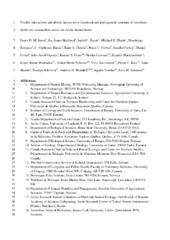| dc.contributor.author | Speed, James David Mervyn | |
| dc.contributor.author | Skjelbred, Ina Åsnes | |
| dc.contributor.author | Barrio, Isabel C. | |
| dc.contributor.author | Martin, Michael David | |
| dc.contributor.author | Berteaux, Dominique | |
| dc.contributor.author | Bueno, Guillermo | |
| dc.contributor.author | Christie, Katie | |
| dc.contributor.author | Forbes, Bruce C. | |
| dc.contributor.author | Forbey, Jennifer | |
| dc.contributor.author | Fortin, Daniel | |
| dc.contributor.author | Grytnes, John-Arvid | |
| dc.contributor.author | Hoset, Katrine Skamfer | |
| dc.contributor.author | Lecomte, Nicolas | |
| dc.contributor.author | Marteinsdottir, Bryndis | |
| dc.contributor.author | Mosbacher, Jesper Bruun | |
| dc.contributor.author | Pedersen, Åshild Ø. | |
| dc.contributor.author | Ravolainen, Virve | |
| dc.contributor.author | Rees, Eileen C. | |
| dc.contributor.author | Skarin, Anna | |
| dc.contributor.author | Sokolova, Natalya | |
| dc.contributor.author | Thornhill, Andrew H | |
| dc.contributor.author | Tombre, Ingunn | |
| dc.contributor.author | Soininen, Eeva M | |
| dc.date.accessioned | 2019-08-15T09:52:07Z | |
| dc.date.available | 2019-08-15T09:52:07Z | |
| dc.date.issued | 2019 | |
| dc.Published | Speed JDM, Skjelbred IÅ, Barrio IC, Martin MD, Berteaux D, Bueno G, Christie K, Forbes BC, Forbey, Fortin, Grytnes J, Hoset KS, Lecomte NAF, Marteinsdottir B, Mosbacher JB, Pedersen ÅØ, Ravolainen V, Rees, Skarin A, Sokolova N, Thornhill AH, Tombre I, Soininen EM. Trophic interactions and abiotic factors drive functional and phylogenetic structure of vertebrate herbivore communities across the Arctic tundra biome. Ecography. 2019;42(6):1152-1163 | eng |
| dc.identifier.issn | 1600-0587 | en_US |
| dc.identifier.issn | 0906-7590 | en_US |
| dc.identifier.uri | http://hdl.handle.net/1956/20680 | |
| dc.description.abstract | Communities are assembled from species that evolve or colonise a given geographic region, and persist in the face of abiotic conditions and interactions with other species. The evolutionary and colonisation histories of communities are characterised by phylogenetic diversity, while functional diversity is indicative of abiotic and biotic conditions. The relationship between functional and phylogenetic diversity infers whether species functional traits are divergent (differing between related species) or convergent (similar among distantly related species). Biotic interactions and abiotic conditions are known to influence macroecological patterns in species richness, but how functional and phylogenetic diversity of guilds vary with biotic factors, and the relative importance of biotic drivers in relation to geographic and abiotic drivers is unknown. In this study, we test whether geographic, abiotic or biotic factors drive biome‐scale spatial patterns of functional and phylogenetic diversity and functional convergence in vertebrate herbivores across the Arctic tundra biome. We found that functional and phylogenetic diversity both peaked in the western North American Arctic, and that spatial patterns in both were best predicted by trophic interactions, namely vegetation productivity and predator diversity, as well as climatic severity. Our results show that both bottom–up and top–down trophic interactions, as well as winter temperatures, drive the functional and phylogenetic structure of Arctic vertebrate herbivore assemblages. This has implications for changing Arctic ecosystems; under future warming and northward movement of predators potential increases in phylogenetic and functional diversity in vertebrate herbivores may occur. Our study thus demonstrates that trophic interactions can determine large‐scale functional and phylogenetic diversity just as strongly as abiotic conditions. | en_US |
| dc.language.iso | eng | eng |
| dc.publisher | Wiley | en_US |
| dc.subject | Functional traits | eng |
| dc.subject | Functional diversity | eng |
| dc.subject | Herbivory | eng |
| dc.subject | Phylogenetic diversity | eng |
| dc.subject | Community structure | eng |
| dc.subject | Biogeography | eng |
| dc.subject | Trophic interactions | eng |
| dc.title | Trophic interactions and abiotic factors drive functional and phylogenetic structure of vertebrate herbivore communities across the Arctic tundra biome | en_US |
| dc.type | Peer reviewed | |
| dc.type | Journal article | |
| dc.date.updated | 2019-05-22T10:35:33Z | |
| dc.description.version | acceptedVersion | en_US |
| dc.rights.holder | Copyright 2019 The Authors. Ecography copyright 2019 Nordic Society Oikos | en_US |
| dc.identifier.doi | https://doi.org/10.1111/ecog.04347 | |
| dc.identifier.cristin | 1699459 | |
| dc.source.journal | Ecography | |
| dc.source.pagenumber | 1152-1163 | |
| dc.relation.project | Norges forskningsråd: 262064 | |
| dc.identifier.citation | Ecography. 2019, 42 (6), 1152-1163. | |
| dc.source.volume | 42 | |
| dc.source.issue | 6 | |
